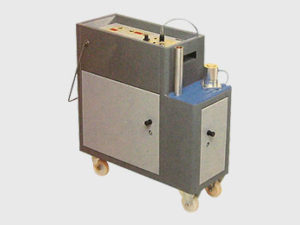Spindle Centering Device

- Facilitates Precise Centering of Spindles with Respect to Ring
- Wrong Centering due to Fatique, Visual Misjudgements Totally Eliminated
- Accuracy to the Tune of 0.025 mm
- Specially Designed Trolley for Easy Operations
- LED Indications in X and Y Directions on Front Panel
- Reduce Peak Tensions, End Breakages, Prematured Wear of Ring & Travellers
- Works on Mains or Rechargeable Battery
Result : Improve Quality, Higher Production, Longer Life of Ring and Ring Travellers.
Is Electronic Spindle Centering Expensive & Time Consuming
Yes, of course it is if you ignore the benefits you get over the conventional method of spindle centering.
The conventional method using fiber bush is observed to take about 3 to 4 hours for a ring frame with 476 spindles. The same ring frame, if gauged using a Electronic Spindle Centering Device takes 6 to 8 hours. Let us try to analyze, why and if at all, to what advantage?
After centering, it is also possible to carry out a few checks on spindle and ring-rail. Rotating the spindle manually, and keeping it in different positions, the eccentric movement or a bent spindle can be found out. Moving the ring-rail up and down, the rail play can be detected. This way, 80% of the CMRS results can be achieved. The ATIRA advocated CMRS method is known to need 40 hours of meticulous working.
The sensing probe of the Spindle Centering Device, is fabricated with very good mechanical accuracy. This probe has to be put on each ring individually, in the procedure of gaguing. Therefore, dimensional accuracy in the ring diameter or ovality of ring can be immediately spotted. (e.g. rings of 42mm Di and 1 & 5/8″ Di are many times mixed, which may go unnoticed.)
Unfortunately Spindle Centering Device has no capacity to correct the defects detected by it. However it does prove to be an important aid for one who wants to set right the flaws. And once you attend to them, it may not be necessary to gauge ring frames more frequently. Psychologically, one does not like to notice such defects. But if this mental barrier is overcome, the benefits of using electronic Spindle Centering Device will be appreciable.
The accuracy achieved with electronic Spindle Centering Device is of the order of thousandth part of an inch. This can never be guaranteed in conventional method. With this kind of accuracy, it is needless to say, the end breakages will reduce substantially. Not only that, the spindle speed may be increased by 2 to 3%.
Another advantage of electronic Spindle Centering Device is that it may be carried out in stationary condition (i.e. without running the ring frame), thus saving power costs. However, it is also possible to gauge or check in running condition. So, if a Ring Data Acquistion system is installed; only the particular ring – spindle pair recording more breakages, may be gauged, while the production is undistrubed.
If you club together advantages like less end breakages, increased speed and prolonged gauging schedules, the pay-back period of electronic Spindle Centering Device can be about 3 months, depending on the material and count variations.
So, is electronic Spindle Centering really expensive? And time consuming? Is it really?
Q & A
The ring frame is fixed spindle, fixed ring type. That necessarily means that no adjustments are possible, once the initial setting is done. However, does it mean that no adjustments are required ? With the help of Spindle Centering Device, it is possible to monitor the guaging at intervals. Necessary steps may be taken at proper time.
One more thing, if you have a reliable means to ensure correct centering at the time of installation and commissioning of such ring frame, you will be definitely benefited, as you will get more accurate setting. Some mills have bought the Spindle Centering Device, only to facilitate precise erection of the ring frame.
Taking into consideration, the geometry of the ring frame, it is expected that the axis of the spindle should be perpendicular to the plane of the ring and the ring rail. Although this is the ideal condition, nothing ideal ever exists in this brutal world. This will be apparent, if you see the level difference in the ring and bush, on all sides. The ring rail leveling may be incorrect, especially in the Y direction. We use height gauges and other means, which helps the setting in the X direction. But nothing is of help in Y direction, if ring rail is buckled or warped. Therefore, virtually the gauging appears to be improper.
However, confirming accuracy of the Spindle Centering Device, with a fibber bush sounds something like looking for error in the vernier caliper, using an ordinary foot scale.
When we initially start using Spindle Centering Device, since it is a new concept. a new way to work, it is quite understandable,that it will take more time. The device is very sensitive, as it has to stand to a good level of accuracy. But once he gets, proper judgment of the direction in which the spindle / ring has to be moved, to get the expected change in the meter reading; (i.e. to bring both axis to 0-0), he will be able to do the gauging quickly.
An experiment carried out at VISHWABHARATI SPINNING MILLS, Vadamadurai, TN, clearly indicates this phenomenon. However, even if we assume that a little more time has to be spent, the accuracy that is achieved, will justify it. The reduction in the end breakages or increase in speed will definitely compensate for the time loss at gauging stage, if any.
Can we increase the speed of the ring frame, after gauging with electronic Spindle Centering Device?
Although it is at the sole descretion of the S pinning Manager, as to what speed, the ring frame should be run, we have observed that to take advantage of reduced end breakages; many times the spindle speed is increased to the extent of 5%.
Yes. very much. By using the ring data information, the problematic spindle can be specifically attended using Spindle Centering Device, to eliminate any contribution due to disturbed gauging.


